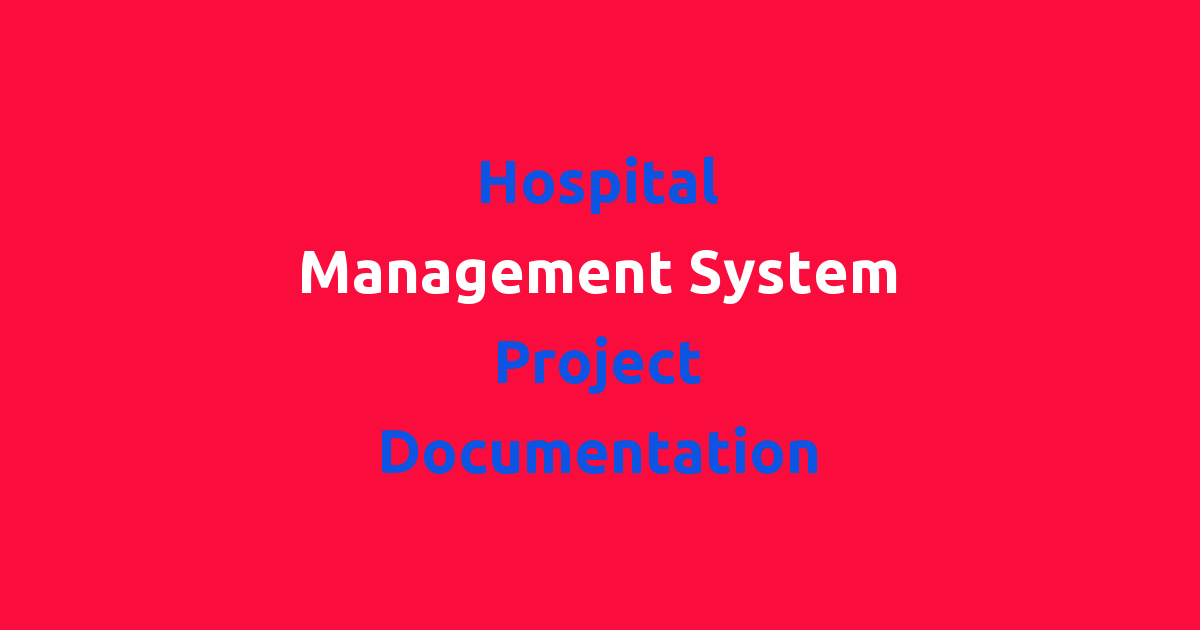Documentation for the hospital management system project.
Introduction
The healthcare industry is a crucial sector that requires efficient management to provide quality services to patients. Hospital management systems play a vital role in streamlining administrative and medical processes in healthcare facilities. In this project report, we will explore the documentation of a proposed hospital management system aimed at improving the overall efficiency and effectiveness of hospital operations.
Problem Statement
The existing hospital management system in many healthcare facilities is often manual and outdated, leading to inefficiencies and errors in patient care. Paper-based processes are time-consuming and prone to mistakes, making it challenging for healthcare providers to deliver timely and accurate services to patients. The lack of integration between various departments within a hospital also contributes to a disjointed workflow, further impacting patient care and satisfaction.
Existing System
The current hospital management system relies heavily on manual processes, such as paper-based medical records, appointment scheduling, and billing. This manual system is not only time-consuming but also error-prone, leading to issues such as lost or misplaced files, duplicate entries, and incorrect patient information. The lack of integration between different departments, such as the lab, pharmacy, and billing, further complicates the workflow and increases the likelihood of errors.
Disadvantages
Some of the disadvantages of the existing hospital management system include:
1. Time-consuming processes: Manual entry of patient information, appointment scheduling, and billing is time-consuming and inefficient.
2. Error-prone: Paper-based records are prone to errors, such as duplicate entries, incorrect information, and lost files.
3. Lack of integration: The lack of communication and integration between different departments within a hospital leads to a disjointed workflow and reduced efficiency.
4. Limited accessibility: Paper-based records are not easily accessible to all healthcare providers, leading to delays in patient care.
Proposed System
The proposed hospital management system aims to address the limitations of the existing system by introducing a comprehensive and integrated digital platform. This system will automate administrative and medical processes, such as appointment scheduling, patient registration, medical records management, billing, and inventory management. By digitizing these processes, the proposed system will improve efficiency, accuracy, and overall quality of patient care.
Advantages
Some of the advantages of the proposed hospital management system include:
1. Improved efficiency: Automation of processes will reduce manual errors and save time, leading to improved efficiency in hospital operations.
2. Enhanced accuracy: Digital records are less prone to errors, ensuring accurate and up-to-date patient information.
3. Seamless integration: The proposed system will facilitate communication and data sharing between different departments, promoting a seamless workflow.
4. Enhanced accessibility: Digital records will be easily accessible to all healthcare providers, enabling timely and informed decision-making.
Features
Some of the key features of the proposed hospital management system are as follows:
1. Patient registration: Streamlined process for patient registration, including demographic information, insurance details, and medical history.
2. Appointment scheduling: Integrated calendar system for scheduling patient appointments with healthcare providers.
3. Medical records management: Digital storage of patient records, including diagnosis, treatment plans, and medication history.
4. Billing and invoicing: Automated billing system for generating invoices, tracking payments, and managing insurance claims.
5. Inventory management: Real-time tracking of medical supplies and equipment, ensuring adequate stock levels and timely reordering.
6. Reporting and analytics: Customizable reports and dashboards for monitoring key performance indicators and improving decision-making.
Conclusion
In conclusion, the proposed hospital management system offers a comprehensive and integrated solution to the limitations of the existing system. By digitizing administrative and medical processes, the proposed system aims to improve efficiency, accuracy, and overall quality of patient care in healthcare facilities. With its advanced features and benefits, the proposed system has the potential to revolutionize hospital operations and enhance the delivery of healthcare services to patients.

